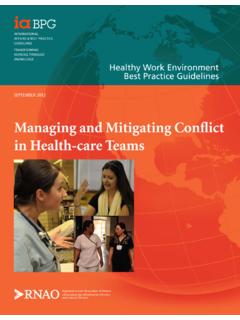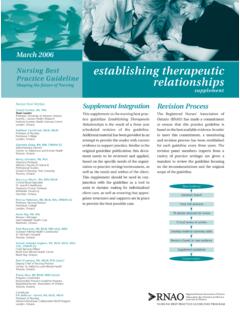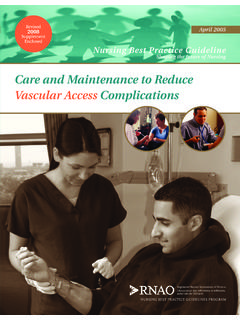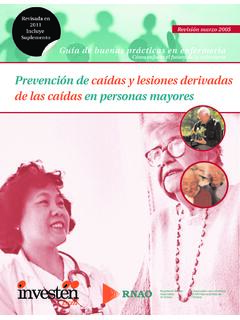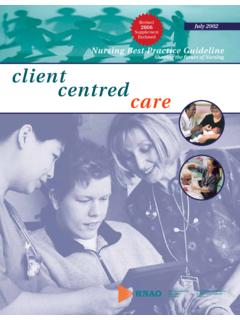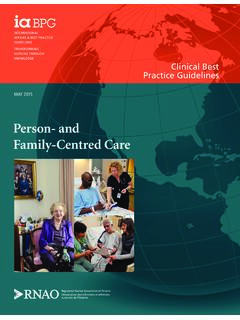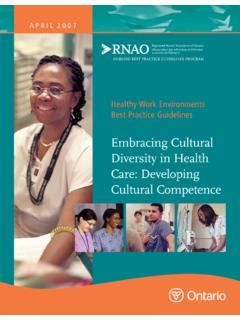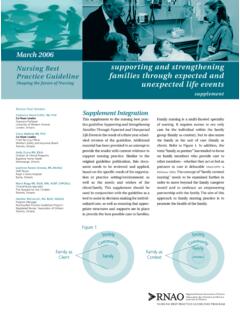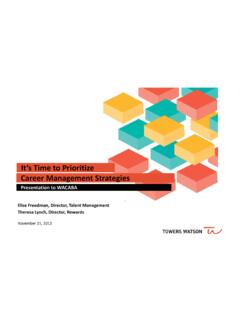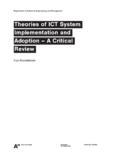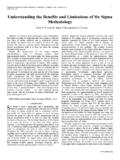Transcription of establishing therapeutic relationships - rnao.ca
1 Nursing Best Practice GuidelineShaping the future of NursingSupplement IntegrationThis supplement to the nursing best prac-tice guideline establishing TherapeuticRelationshipsis the result of a three yearscheduled revision of the material has been provided in anattempt to provide the reader with currentevidence to support practice. Similar to theoriginal guideline publication, this docu-ment needs to be reviewed and applied,based on the specific needs of the organi-zation or practice setting/environment, aswell as the needs and wishes of the supplement should be used in con-junction with the guideline as a tool toassist in decision making for individualizedclient care, as well as ensuring that appro-priate structures and supports are in placeto provide the best possible ProcessThe Registered Nurses Association ofOntario (RNAO) has made a commitmentto ensure that this practice guideline isbased on the best available evidence.
2 In orderto meet this commitment, a monitoringand revision process has been establishedfor each guideline every three years. Therevision panel members (experts from avariety of practice settings) are given amandate to review the guideline focusingon the recommendations and the originalscope of the therapeuticrelationshipssupplementRevisi on Panel MembersCheryl Forchuk, RN, PhDTeam LeaderProfessor, University of Western OntarioScientist, Lawson Health ResearchInstitute London Health Sciences CentreLondon, OntarioKathleen Carmichael, BScN, MScNProfessor of NursingFanshawe CollegeLondon, OntarioGabriella Golea, RN, MN, CPMHN (C)Administrative DirectorCentre for Addictions and Mental Health Toronto, OntarioNancy Johnston, RN, PhDAssociate ProfessorAtkinson Faculty of Liberal & Professional StudiesSchool of Nursing, York UniversityToronto, OntarioMary-Lou Martin, RN, MEd MScNClinical Nurse SpecialistSt.
3 Joseph s HealthcareAssociate Clinical ProfessorMcMaster UniversityHamilton, OntarioPatricia Patterson, RN, BScN, MA, CPMHN (C)Professor, Nursing DivisionFanshawe CollegeLondon, OntarioKaren Ray, RN, MScResearch ManagerSaint Elizabeth Health CareMarkham, OntarioTrish Robinson, RN, BScN, DBS (dip), MEdOutreach Mental Health CoordinatorSt. Michael s HospitalToronto, OntarioSelinah Adejoke Sogbein, RN, BScN, MHA, MEd,CHE, CPMHN (C)Chief Nursing OfficerNorth East Mental Health CentreNorth Bay, OntarioRani Srivastava, RN, MScN, PhD (cand.)Deputy Chief of Nursing PracticeCentre for Addiction and Mental HealthToronto, OntarioTracey Skov, RN, BScN, MSN (cand.)Program CoordinatorNursing Best Practice Guideline ProgramRegistered Nurses Association of OntarioToronto, OntarioContributorPat Bethune - Davies, RN, BScN, MScNProfessor of NursingWestern-Fanshawe Collaborative BScN ProgramLondon, OntarioMarch 2006 Literature SearchYield 328 abstracts79 articles retrieved for reviewCritical review of articlesDevelop evidence summary tableRevisions based on new evidenceSupplement publishedDisseminationNew Evidence2 The following definition will be added to those in the Definition of Terms section starting on page 12 of the Our intentions remind us of what is important and inform our choices and actions.
4 Thinking related to intentionality connectswith the concepts of consciousness and energy. For example, if our conscious intentionality is to hold thoughts that contrast to having thoughts to control and have power over, the consequence will be different based on the differentlevels of consciousness and the energy associated with different thoughts (Watson, 2005).Changes made to the Framework for therapeutic relationships Figure 1 are highlighted below:Requisite Capacities for establishing therapeutic RelationshipsPhases of therapeutic RelationshipBackgroundknowledgeSelf-Awar enessSelf-knowledgeEmpathyAwareness of ethics,boundaries & limitsof professional roleKnowledge ofinterpersonal,caring&developmenttheory Knowledge of culture,diversity influences anddeterminants of healthKnowledge of personBeginning or orientationphaseMiddle orworkingphaseEnding or resolutionphaseKnowledge ofhealth/illnessKnowledge ofthe broadinfluences onhealth careand healthcare policyKnowledge ofsystemsRequisite Knowledge for establishing therapeutic Relationships3 changed unchanged+additional informationSummary of EvidenceThe following content reflects the changes made to the original publication (2002)
5 Based on the consensus of thereview 1 The nurse must acquire the necessary knowledge to participate effectively in therapeutic subheading on page 18, # 2 is changed to Knowledge of interpersonal, caring and development theory. A 5th bullet under subheading #2 will include the following: Caring theories (Benner, 1989; Leininger, 1988; Watson, 1999; Watson 2005.)A 4th bullet under the subheading, Knowledge of person , on page 19 will include the following: Understanding different ways/patterns of knowing: empirics, personal, ethical, aesthetic and following bullet is to be added under #4 subheading Knowledge of person , on page of ways/patterns of knowing: empirical (evidence based), personal, ethical, aesthetic and Literature SupportsAgency for Healthcare Research and Quality, 2004; Coffman, 2004; Cole & McLean, 2003; McCabe & Priebe, 2004; Myers, 2003; Schillinger, Machtinger,Wang, Chen, Win, Palacios, 2004; Shirk, & Karver, 2003 Recommendation 2 Establishment of a therapeutic relationship requires reflective practice.
6 This concept includes the required capacitiesof: self-awareness, self-knowledge, empathy, awareness of ethics, boundaries and limits of the professional 2 has been adapted to include the awareness of ethics which is in keeping with changes made tothe Framework for therapeutic relationships . The following content is a change under the Assumptions headingon page 20. The second bullet, second sentence will read, Thus a nurse, with self-knowledge is: purposeful, inten-tional and is able to consider a range of ways of being with the client. An additional bullet is added at the end of the bulleted list under the Assumptions heading on page 20. The concept of ways and patterns of knowing recognizes that there are multiple ways of understanding the world( empirical, aesthetic, personal, ethical).
7 The important tenant is that knowledge is derived from many sourcesand people come to know in different ways (Belenky, Clinchy, Goldberger & Tarule, 1986; Carper, 1978).Additional Literature SupportsBarrett & Berman, 2001; Browne, 1997; Cole & McLean, 2003; Forchuk & Reynolds, 2001; Johansson & Eklund, 2003; Lambert & Barley, 2001; Moyle, 2003;Myers, 2003; Okamoto, 2003 Recommendation 3 The nurse needs to understand the process of a therapeutic relationship and be able to recognize the current phaseof his/her relationship with the Literature SupportsForchuk, Martin, Chan, & Jensen, 2005; Forchuk & Reynolds, 2001; Planavsky, Mion, Litaker, Kippes, & Mehta, 2001 Recommendation 4 All entry-level nursing programs must include in-depth learning about the therapeutic process, including both theo-retical content and supervised Literature SupportsCole & McLean, 2003 + 4 Recommendation 5 Organizations will consider the therapeutic relationship as the basis of nursing practice and, over time, will integratea variety of professional development opportunities to support nurses in effectively developing these must include nursing consultation, clinical supervision and Literature SupportsJohansson & Eklund, 2003; Lambert & Barley, 2001; McCabe & Priebe, 2004.
8 Ramjan, 2004 Recommendation 6 Health care agencies will implement a model of care that promotes consistency of the nurse-client assignment, suchas primary Literature SupportsForchuk & Reynolds, 2001; Moyle, 2003; Planavsky, Mion, Litaker, Kippes, & Mehta, 2001; Ramjan, 2004; Shirk, & Karver, 2003 Recommendation 7 Agencies will ensure that at minimum, 70 per cent of their nurses are working on a permanent, full-time Literature SupportsAiken, Clarke, & Sloane, 2002; Blythe, Baumann, Zeytinoglu, Denton, & Higgins, 2005; Stone, et al., 2003; Recommendation 8 Agencies will ensure that nurses workload is maintained at levels conducive to developing therapeutic 9 Staffing decisions must consider client acuity, complexity level, complexity of work environment, and the availabilityof expert 10 Organizations will consider the nurse s well-being as vital to the development of therapeutic nurse-client relation-ships and support the nurse as 11 Organizations will assist in advancing knowledge about therapeutic relationships by disseminating nursing research,supporting the nurse in using these findings.
9 And supporting his/her participation in the research 12 Agencies will have a highly visible nursing leadership that establishes and maintains mechanisms to promote openconversation between nurses and all levels of management, including senior Literature SupportsCollege of Nurses of Ontario, 2004 Recommendation 13 Resources must be allocated to support clinical supervision and coaching processes to ensure that all nurses haveclinical supervision and coaching on a regular 14 Organizations are encouraged to include the development of nursing best practice guidelines in their annual reviewof performance indicators/quality improvement, and accreditation bodies are also encouraged to incorporate nurs-ing best practice guidelines into their standards.
10 5 implementation StrategiesA current ongoing investigation related to implementation strategies for an intervention based on therapeutic relationships (Forchuk,Reynolds, Jensen, Martin, Sharkey, Ouseley et al., unpublished work)has found the following to be important: On-going champions to provide personal level support Program specific training related to therapeutic relationships which includes discussion of specific examples Documentation systems that support the interventionThe Culturally Responsive therapeutic Relationship (CRTR) project is a project that has received funding from the Change Foundationwith a focus on integration of the RNAO guideline establishing therapeutic Relationshipsand the standards produced by the Collegeof Nurses of Ontario specific to culturally sensitive care.
